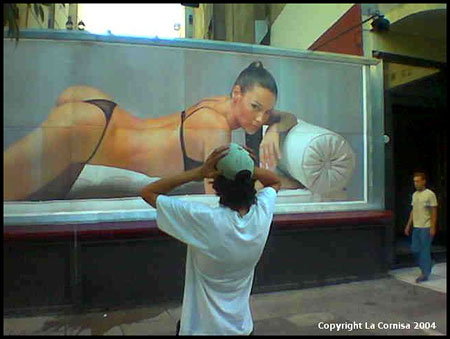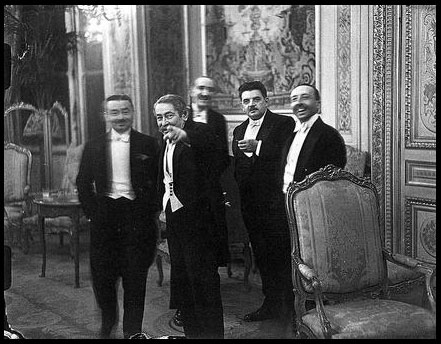|
|
On the last two weeks of January 2004, I trained journalists Alejandra Polack and Juan Martinelli of the Argentinean radio talk show “La Cornisa” (The Cornice) anchored by journalist Luis Majul, in the use of the cameras in their cellular telephones, this would allow instant publication on-line of the photographs during the program. The training was focused on how to use the equipment and the steps they should follow for the images to get to the show’s website throughout the broadcast. The photos are published daily from 6:00 to 9:00, Buenos Aires time, at: http://www.fotomovil.uol.com.ar Juan
Martinelli during an interview in Buenos Aires. In February 2nd (Fotomovil’s opening date) these reporters became the first radio journalists in Argentina –and perhaps the world- that took photographs that could be seen on line. Soon these pictures will be available through WAP (Wireless Application Protocol) or via text message (SMS) in a multimedia cellular telephone. What and Where To boost the information of the photographs published in Fotomovil, I developed the idea of photographs being associated to vector maps to add context and relevance to every image as shown in the following example: This
picture published by Fotomovil showed this controversial billboard This is the real time map that shows the location where the picture was taken. Fotomovil is a project that is to expand immediately to other radio stations in Argentina. It will be used by the sports-news press or even as the first-to-arrive images of a television station. On-line Photography As I was working on this project, I re-read some chapters of Gisele Freund’s book “Photography as a social document” specially the ones dedicated to Erich Salomon and LIFE magazine’s coverage of Winston Churchill’s funeral.
Erich Salomon: (1930) Naive photograph. While I read, on the one hand I thought that the photographs taken with cam-phones by the reporters of “La Cornisa” were recovering (for a moment) the naivety that Erich Salomon’s models once had. On the other hand I realized that the instant on-line distribution of photographs has caused the past production needs of news photography (even the digital one) to look ridiculous, it has modified it radically, changing its role and significance. Playing with a Nokia The images produced with a Nokia 3600 or 3650 have a poor quality, but they are quirky. Carrying a cam-phone entices you to take pictures all the time, because you can do it so swiftly and easily. Shop window in Buenos Aires (J. Gallo Nokia 3600) I read somewhere that cam-phones developed in people a sense of “continuous curiosity”, a greater awareness of the world of images. To sum it up: Cam-phones produce photographers.. During the training of the radio reporters I “played” a lot with the cam-phones and had some peculiar experiences (peculiar because I was taking pictures with a telephone). The kitchen (J. Gallo Nokia 3650) I produced this David Hockney-style view walking in front of the objects. I liked the lighting differences –there is no possibility of controlling the exposure, since the Nokia only has two modes: Standard and Night-; I edited the images to improve the narrative, to show better how my kitchen looks like. My interest in views came from the idea of developing a special tripod for the Nokia that soon will enable the reporters to take 180 and 360-degree views in real time. The sequence of pictures will be sent to a database that will put them together in a Macromedia Flash format. The kitchen night and day (J. Gallo Nokia 3650) Another view of the kitchen with another photograph inserted. Bar Pinhole (J.Gallo Nokia 3600) I discovered that cam-phones are “natural” pinhole cameras with a great depth of field, as shown here. Lame city (J. Gallo Nokia 3650) I was also able to take quite a corny urban picture, the kind that is typically taken with an analog camera. Gigantography and foot (J. Gallo Nokia 3600) I also did this self-portrait using a set of pictures taken with a cam-phone amplified by 700% cropping them to print them in A4 sheets and making a “giant photograph”. Where things are going. Photography is moving ahead. We thought that the victory of digital over analog was the beginning of a new era, but perhaps a bigger revolution will be brought forth by on-line photography, either by sending the photographs from a camera to the Web (snap to server), or from cam-phone to cam-phone (peer to peer). This period of low-resolution photographs should be labeled as the beginning of a new era in photography, perhaps the “Mobile Nièpce” or “Wireless Nièpce” period? It will all happen very fast. The functions and capacities of digital cameras are migrating rapidly to the cam-phones like fish turning into amphibians. These two examples are quite eloquent. A Vodaphone cell phone with a 2-mega-pixel camera and a Samsung with 15 multiple expositions and flash.
This is all happening now, very quietly. Photography is evolving and its changes -as it has happened before- will have a profound effect all over our culture.
Julian Gallo
Related Links
|











